It is used by Australian Government departments and agencies, statutory and non-statutory authorities, the Parliament and Commonwealth courts and tribunals.
Australian Government departments and agencies should refer to the Australian Government Branding Guidelines when undertaking branding exercises.
Guidelines for using the Commonwealth Coat of Arms
PM&C publishes Guidelines on the use of the Commonwealth Coat of Arms.
Individuals can apply to PM&C for permission in writing to use the Commonwealth Coat of Arms (refer to the guidelines for contact details). PM&C has discretion to grant permission in limited circumstances, including for education and for Australian teams competing in international competitions.
Use of the Commonwealth Coat of Arms without permission may breach the Competition and Consumer Act 2010, the Trade Marks Act 1995 and the Criminal Code Act 1995.
Importation of goods bearing the Commonwealth Coat of Arms is prohibited under the Customs (Prohibited Imports) Regulations.
The Commonwealth Coat of Arms must be reproduced accurately. You can download the 1908 and 1912 colour versions of the Commonwealth Coat of Arms:
- The second (current) Commonwealth Coat of Arms (JPG 322 KB)
- The first Commonwealth Coat of Arms (JPG 142 KB)
History of the Commonwealth Coat of Arms
First Commonwealth Coat of Arms
King Edward VII first officially granted the first coat of arms to the Commonwealth of Australia, in a Royal Warrant on 7 May 1908.
The first Coat of Arms was a simple shield of white and blue. On the shield was the cross of St George, with five six-pointed white stars along the cross and six small escutcheons (small shields) around the edge of the shield.
The shield was supported by a kangaroo and an emu standing on a grassy mound and above the shield was the crest containing the seven-pointed gold star of Federation on a wreath of white and blue. The motto 'Advance Australia' was inscribed at the base of the grassy mound.
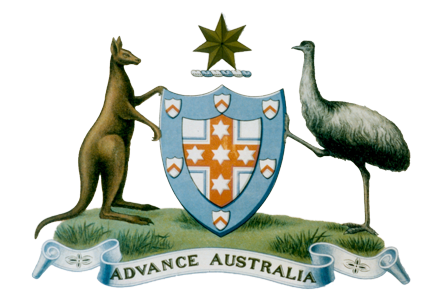
Second Commonwealth Coat of Arms
King George V granted the second Commonwealth Coat of Arms in a Royal Warrant (PNG 231 KB) dated 19 September 1912, which includes a 'blazon', or official description of the Commonwealth Coat of Arms, so the Coat of Arms can be reproduced in any part of the world. The 1912 Coat of Arms is the official Commonwealth Coat of Arms.
The second Commonwealth Coat of Arms was designed because the original Coat of Arms didn't make any reference to the states.
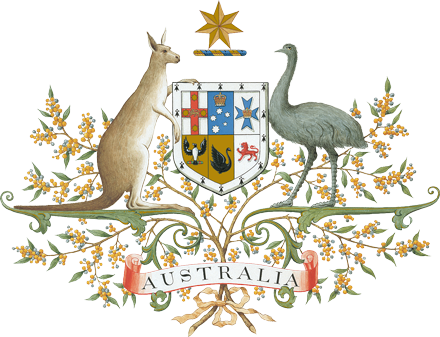
Description of the Commonwealth Coat of Arms
The centre of the shield includes symbols of Australia's six states and the border of the shield symbolises federation.
The shield is held up by the native Australian animals the kangaroo and the emu, which were chosen to symbolise a nation moving forward, based on the fact that neither animal can move backwards easily.
A seven-point gold Commonwealth Star sits above the shield. Six of the star's points represent the Australian states and the seventh point represents the territories.
A wreath of gold and blue sits under the Commonwealth Star. Gold and blue are the Commonwealth Coat of Arms' 'livery', or 'identifying', colours.
Stylised wattle frames the shield and the kangaroo and emu and at the bottom of the shield you will see a scroll containing the word 'Australia'.
There are ten variations of the 1912 Arms – the colour version, four variations of the conventional Arms and five variations of the stylised Arms.
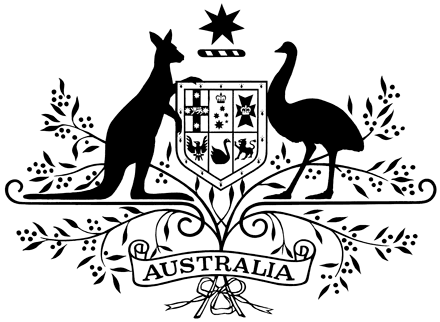
Commonwealth Coat of Arms (conventional)
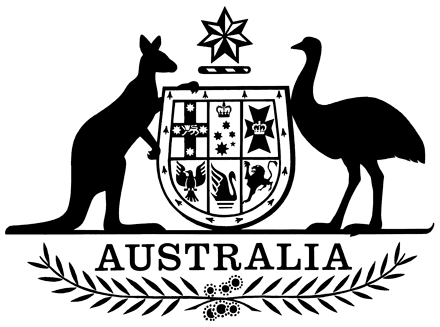
Commonwealth Coat of Arms (stylised)
Description of the shield
Symbols of Australia's six states appear on the shield:
- New South Wales – the Cross of St George with lion and stars
- Victoria – the Southern Cross
- Queensland – a blue Maltese Cross and Crown
- South Australia – the Australian piping shrike
- Western Australia – a black swan
- Tasmania – a red walking lion.
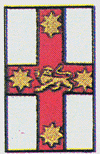
First Quarter
Representing New South Wales
Background silver, featuring the Cross of St George containing an heraldic gold lion, walking to the wearer's right (viewer's left), three paws on the ground, the right forepaw being raised, the head turned so as to face the spectator and the tail curved over the back, and on each arm of the cross an eight-pointed gold star.
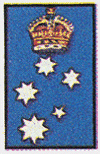
Second Quarter
Representing Victoria
Background blue, containing five stars, one of eight points, two of seven points, one of six points and one of five points (the constellation of the Southern Cross) with an Imperial Crown in normal colours placed above the first star.
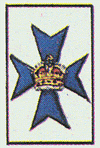
Third Quarter
Representing Queensland
Background silver, containing a blue Maltese Cross surmounted by an Imperial Crown in normal colours.
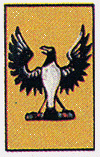
Fourth Quarter
Representing South Australia
Background gold, containing an Australian Piping Shrike perched on a twisted band of green and red (the bird has its back to the viewer).
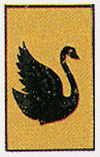
Fifth Quarter
Representing Western Australia
Background gold featuring a black swan swimming to the wearer's left (viewer's right).
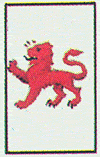
Sixth Quarter
Representing Tasmania
Background silver, featuring a red lion walking to the wearer's right (viewer's left) three paws on the ground, the right forepaw being raised, the head looking forward and the tail curved over the back.
